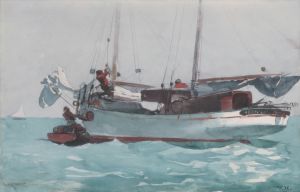
Seagull and Waves
A hand-painted replica of Winslow Homer’s masterpiece Seagull and Waves, meticulously crafted by professional artists to capture the true essence of the original. Each piece is created with museum-quality canvas and rare mineral pigments, carefully painted by experienced artists with delicate brushstrokes and rich, layered colors to perfectly recreate the texture of the original artwork. Unlike machine-printed reproductions, this hand-painted version brings the painting to life, infused with the artist’s emotions and skill in every stroke. Whether for personal collection or home decoration, it instantly elevates the artistic atmosphere of any space.
Winslow Homer, an American landscape painter and printmaker, is renowned for his marine subjects. One of his notable works is "Seagull and Waves," which exemplifies his mastery in capturing the dynamic and often tumultuous relationship between the sea and its surrounding environment. Although specific details about the painting "Seagull and Waves" are limited, Homer's broader body of work provides context for understanding his artistic approach and thematic interests.
Homer was born on February 24, 1836, in Boston, Massachusetts, and began his career as a commercial illustrator. He gained recognition for his depictions of the American Civil War, working as a freelance illustrator for Harper's Weekly. After the war, Homer transitioned to painting, focusing on scenes of rural American life and the natural world. By the 1870s, he had developed a keen interest in marine subjects, which would become a defining aspect of his oeuvre.
Homer's fascination with the sea is evident in many of his works, where he often portrayed the power and beauty of the ocean. His time spent in coastal locations, such as Cullercoats in England and Prouts Neck in Maine, greatly influenced his artistic perspective. These settings provided him with firsthand experiences of the sea's changing moods and the lives of those who lived and worked by it.
In "Seagull and Waves," Homer likely captures the essence of the sea's relentless energy and the solitary presence of a seagull amidst the waves. While specific details about this painting are scarce, it can be inferred that Homer employed his characteristic style, marked by a keen observation of nature and a focus on the interplay of light and shadow. His use of watercolor and oil paints allowed him to convey the fluidity and movement of water, a technique that is evident in many of his marine paintings.
Homer's marine works often explore themes of human struggle against nature, the isolation of individuals within vast landscapes, and the sublime beauty of the natural world. These themes resonate in "Seagull and Waves," where the solitary seagull may symbolize resilience and adaptability in the face of nature's immense power.
Throughout his career, Homer received critical acclaim for his ability to depict the American landscape with authenticity and emotional depth. His works are celebrated for their technical skill and their ability to evoke a sense of place and atmosphere. Today, Homer is regarded as one of the foremost American painters of the 19th century, and his marine paintings continue to be studied and admired for their artistic and historical significance.
While "Seagull and Waves" may not be as widely documented as some of Homer's other works, it remains a testament to his enduring fascination with the sea and his ability to capture its essence on canvas. Homer's legacy as a master of marine art endures, and his paintings continue to inspire and captivate audiences around the world.


















